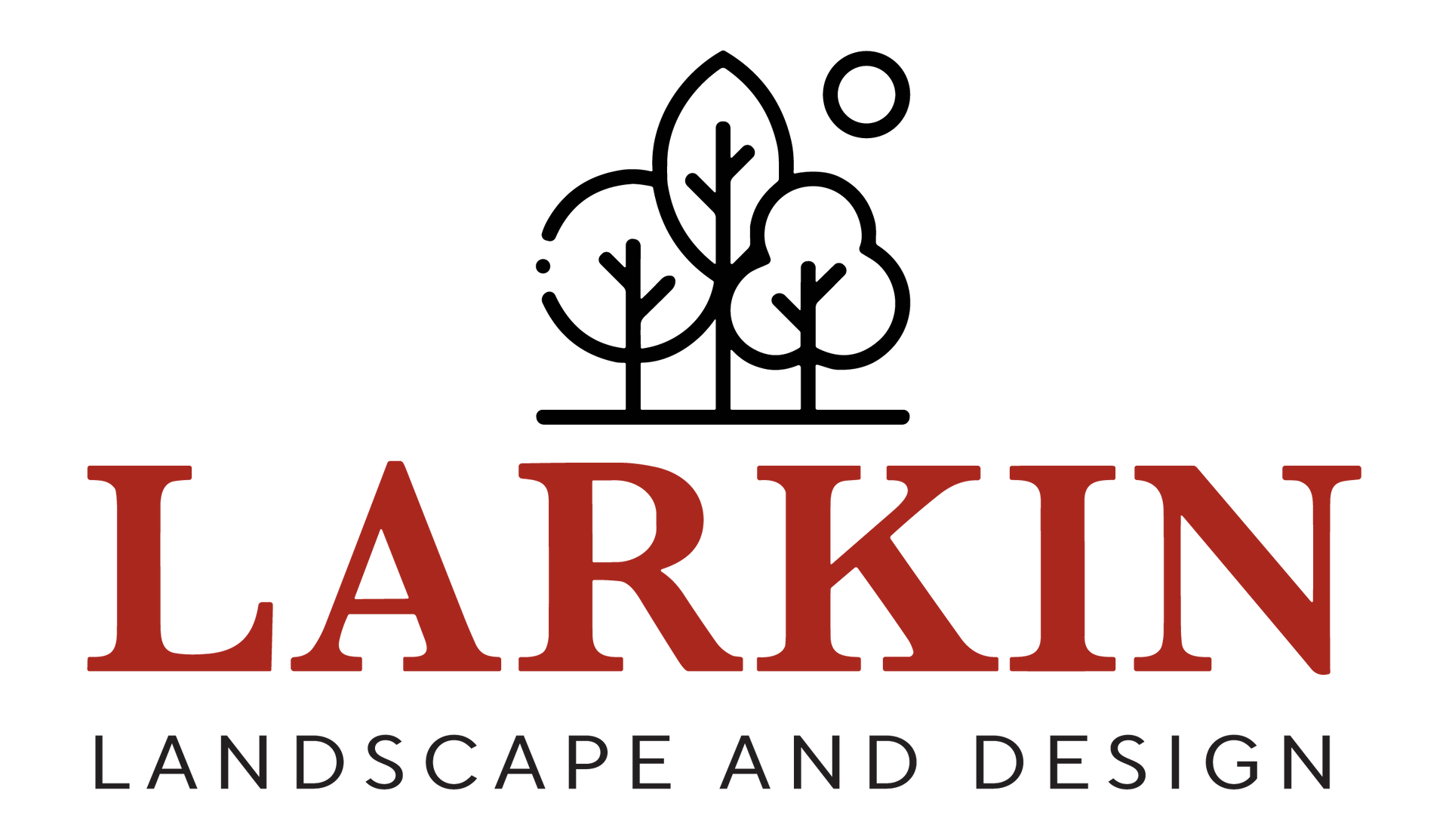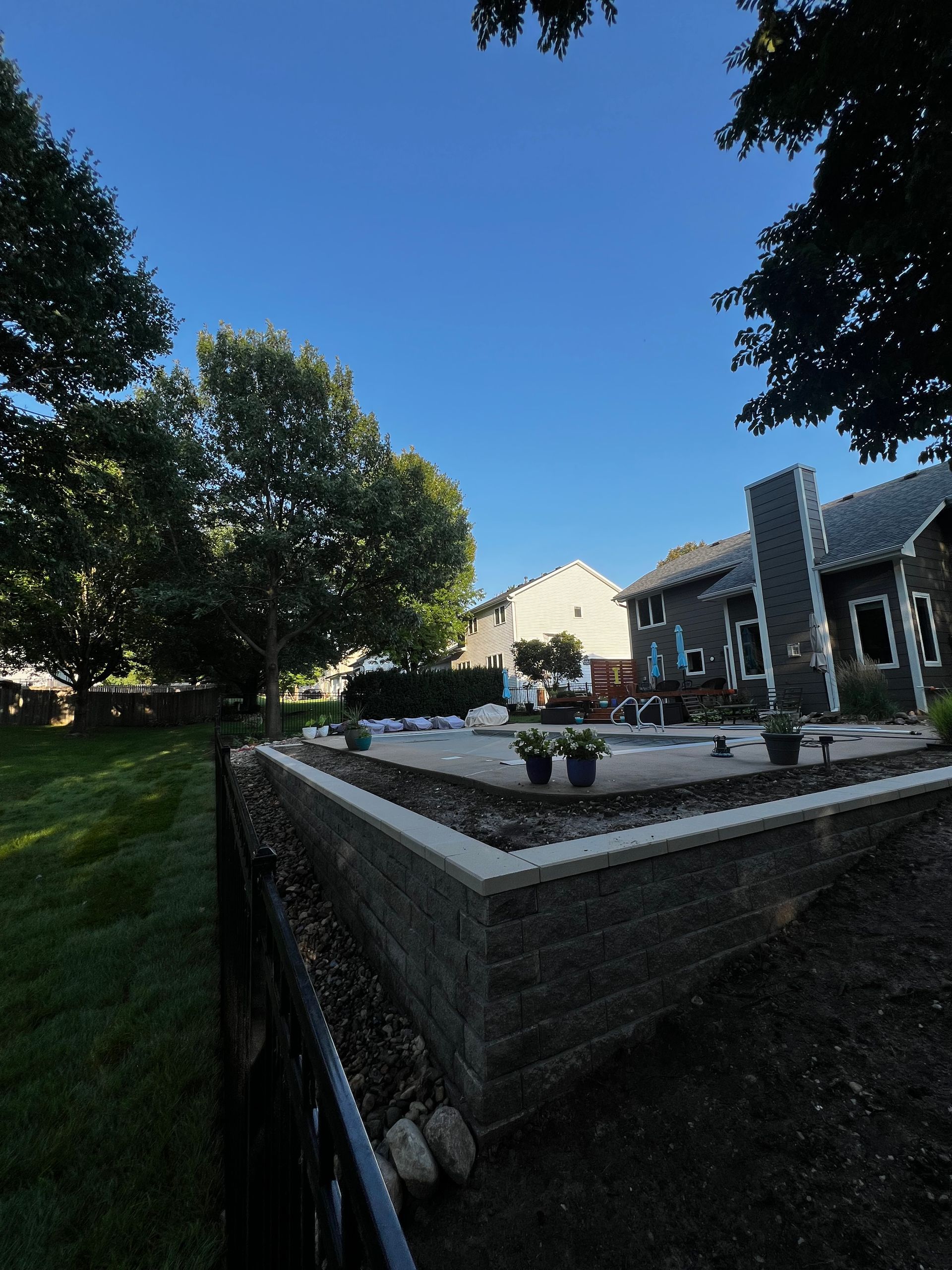Retaining Walls in Iowa: Costs, Drainage & Erosion Control
Retaining Walls in Iowa: When You Need One & How Much They Cost
If you’ve ever looked at your sloped yard in Iowa and wondered whether you need a retaining wall, this post is for you. At Larkin Landscape & Design, we’ve worked in yards across Iowa, dealing with slopes, run-off, soil shifting, and landscapes that just don’t feel stable. Let’s dig into when a retaining wall makes sense, what it does (especially for drainage and erosion control), and get realistic about cost so you’re not surprised. Because yes, a retaining wall can be a smart investment only if done in the correct way.

When Do You Need a Retaining Wall in Iowa?
Let’s talk about the “why” first. In Iowa we deal with cold winters, freeze-thaw cycles, heavy spring rains, and gentle slopes that quietly move soil over time. These conditions make some yards prime candidates for a retaining wall. Here are some key signs:
Your yard has a noticeable grade change
you step down from one level of lawn or patio and the other side drops off. That drop might be fine visually, but it also means soil is under pressure.
You see soil movement or erosion
mulch or dirt washing out after rain, soil next to a patio or driveway shifting, or bare patches where water flows down the slope. A properly built wall can interrupt that movement and give you a stable zone.
You have standing water or run-off behind a low bank
especially next to a structure or patio. That water exerts pressure behind the slope, and without proper drainage, it can undermine the soil.
You’re looking to create usable space
for example a level patio, garden bed, or seating area on a sloped yard. A retaining wall not only holds back soil but it also gives you the flat zone you may want.
You need erosion control
maybe the yard above the planting bed is slipping, the foundation is near a slope, or you have clay soil that drains slowly, the wall and good drainage behind that wall helps manage that.
In short - If your yard is shifting, draining badly, or you want to tame a slope into something usable, a retaining wall in Iowa might be just the fix.
What a Good Retaining Wall Does (and What to Watch)
A well-designed wall addresses three big issues: the soil load, water / drainage behind the wall, and long-term durability in our Iowa climate.
Soil & Structural Load
A retaining wall is literally holding back soil. That means it needs to resist the horizontal pressure of soil and any extra (water, roots, freeze-thaw) behind it. If you ignore those forces, the wall may bow, crack, or fail. Materials, reinforcement, and foundation matter.
Drainage Behind the Wall
This is massively important. In Iowa especially, water wants to find a path. If water accumulates behind the wall, the increased pressure can collapse it or shorten its lifespan. This is where “drainage behind wall” begins - proper back-fill, perforated pipe, weep holes, gravel foundation, all the hidden work that makes the wall perform, not just look good.
Erosion Control & Usability
Once you have the structural and drainage pieces right, the wall becomes a tool for erosion control and usable space. It gives you flat planting beds, patios, steps, seating zones while keeping the slope in check. As our Iowa installer says: “Landscape retaining walls improve drainage and reduce erosion.”
Durability in Iowa Conditions
In Iowa we have freeze-thaw cycles, potentially wet springs, clay or loam soils, and slope movement. A retaining wall must be built with all of these in mind: proper base, materials suited for our climate, and drainage that handles more than a light rain. Cutting corners here may lead to higher cost later.
Typical Costs in Iowa: What to Expect
Let’s look at numbers - because cost is always a major question. Note: every yard is unique. These are ballparks for Iowa and we’ll point out what makes your cost go up or down.
Local Iowa Cost Snapshot
● In the Iowa City area, average retaining wall projects ranged around
$2,525 to $3,621 based on some recent data.
● For drainage behind a wall (which is a major component), costs might include things like gravel backfill at
$15-30 per cubic yard, filter fabric installation at
$0.50-1.00 per sq ft, excavation & grading $1,000-3,000 in Iowa City.
● General national guidance says cost can run about $35–$65 per square foot installed.
Breaking It Down: “Block Retaining Wall Cost”
Block (interlocking concrete) is popular in Iowa for residential yards.
●
For a basic wall, the price per square foot might be around $20-$35, and
for a premium concrete wall, the price per square foot is around $30-50 in Iowa City.
●
Blocks that are arranged
with curves, stepped heights, integrated seating or lighting will cost more.
●
Wall height matters
- higher walls require deeper footings, reinforcement and sometimes a structural engineer, big jump in cost.
●
Access & slope: you should expect higher labor costs, if you need heavy equipment, haul materials uphill, or work in tight spaces.
●
Drainage and site prep: If soil is poor, you have water issues, or need drainage behind the wall, that adds noticeable cost (but skipping it risks failure).
Example Estimate
Imagine you want a 20-foot long, 3-foot high interlocking block wall in Central Iowa. Suppose the cost is $25 per square foot (common middle ground). If wall face area is approx 20 ft × 3 ft = 60 sq ft → 60 × $25 = $1,500 (materials + labor, basic). Then add drainage/backfill/site prep maybe $500-$1,000. So you might see something like $2,000-$3,000 for that sized wall. If you raise height, add curves, or the slope is steep, the cost could go much higher.
Using Iowa City range: $2,500-$3,600 fits that sized job. Good to align expectations around those numbers.
How to Approach the Project with Larkin Landscape & Design
Here at Larkin Landscape & Design, we believe in doing it right, so your retaining wall works hard and looks great. Here’s how we typically guide homeowners in Iowa through the process:
1. Site inspection & conversation
We thoroughly inspect your yard, talk about the slope, what you’re trying to achieve (erosion control, patio, garden bed, etc.), and look for water issues / soil conditions.
2. Recommendation of material and design
Based on your choice and the site, we propose materials (block, stone, concrete, etc.), height/length of wall, drainage plan behind the wall, and an estimate of cost. We’ll also check if engineering or local permitting is required (if wall height > -4 ft or significant load).
3. Drainage and erosion control planning
We don’t just stack blocks. We properly design drainage behind the wall (gravel, pipe, weep holes), base preparation (compaction, proper footings), and erosion control (especially slope runoff). We treat drainage behind the wall as a vital part of the cost and design.
4. Installation
Our team handles everything with precision, whether it’s the excavation, base prep, block installation, back-filling, and final grading/landscape around it. We keep disruption minimal and work with Iowa’s soils and climate in mind.
5. Finishing touches & long-term maintenance advice
We help finish the area, whether that means planting behind/above the wall, integrating a patio, or making sure water is diverted away from the base of the wall. We also advise on inspection and maintenance (e.g., check drainage annually, look for bulging, ensure water isn’t pooling).
6. Cost transparency
We provide itemized quotes - materials, labor, drainage/backfill, site prep, etc. That way you understand where things cost more or less. A block retaining wall cost will depend heavily on height, length, site access, and drainage.
Tips to Save Money (Without Cutting Corners)
Since cost is always a first thought in the mind, here are some ways to be smart about your budget while still doing a good job.
Keep wall height moderate
Lower walls (under 4 feet) avoid needing heavy engineering and deep footings, this way you can save huge cost.
Choose a standard material
Interlocking concrete blocks tends to give good value rather than exotic stone or highly customized shapes.
Simplify shape
Straight paths cost less than multiple curves, corners, or steps down multiple levels.
Address drainage early
Fixing the drainage and base prep before it gets worse or damages your whole wall is cheaper.
Do some finishing of the landscaping yourself
Maybe you add plants, mulch, or groundcover around the wall after installation to save labor.
Get multiple quotes
Understand what each contractor is including (especially drainage behind wall, base prep, permits) so you compare apples to apples.
Choose the right season
In Iowa doing work when ground isn’t frozen often saves time/labor.
What Happens if You Skip “Behind the Wall” Work?
One of the biggest mistakes we see is putting a retaining wall in and not giving enough thought to what’s behind the wall - the drainage, the soil, how water moves. If you skimp this, you face possible issues: bowing of wall, cracks, failure, higher cost down the road. That’s why things like “drainage behind wall” and “erosion control” are so important. If your wall is holding back slippery soil and water, you must give full attention to the drainage.
In Iowa especially: water from spring thaw, heavy rains, snowmelt matters, if that water is trapped behind your wall, you’ll have problems. So proper arrangements like back-fill, gravel, pipe, weep holes etc. matters.

FAQ – Common Questions Iowa Homeowners Ask
●
Do I need a permit for a retaining wall in Iowa?
Often yes, especially if the wall is over 3 - 4 feet high, or is near a structure/foundation. The local municipality will have rules. For example, one Iowa City source says walls taller than 4 feet may need permits & engineering.
●
Is natural stone better than blocks?
Stone looks fantastic and lasts long, but it’s more expensive. Block gives very good value and is widely used for residential walls in Iowa. Material choice affects cost significantly.
●
How long will a well-built retaining wall last?
With good materials, drainage, base prep and regular inspection, a wall can last decades. Materials suited for Iowa’s climate (freeze-thaw, soils) are the key.
●
What about slopes or hills with lots of soil behind the wall?
Steeper slopes and deeper soil loads increase cost, need stronger design, more drainage/back-fill and sometimes geogrid reinforcement. It’s more complex, but manageable.
Final Words: Is it Worth It?
Yes only if it is done right. A well-designed retaining wall in Iowa does more than to just look nice. It controls erosion, stabilizes the yard, creates usable space, protects your property foundation, and improves the overall landscape. The cost is very real, but when you consider what you’re avoiding (soil collapse, water damage, unusable slope) it often makes sense.
At Larkin Landscape & Design, we believe in making recommendations that are right for your yard by not just building a wall because “everyone has one.” If your yard shows signs we discussed (slope, erosion, drainage issues), it’s worth exploring. And if you move forward, let’s make sure it’s done the right way - considering retaining walls Iowa, block retaining wall cost, drainage behind wall, and erosion control - so you get long-term value.
If you’d like us to walk your property and inspect it thoroughly, evaluate your slope and drainage, and provide a clear estimate, we’d be glad to help. Give us a call and let’s see how we can turn your slope into something stable, usable, and beautiful.
Recent Blogs







